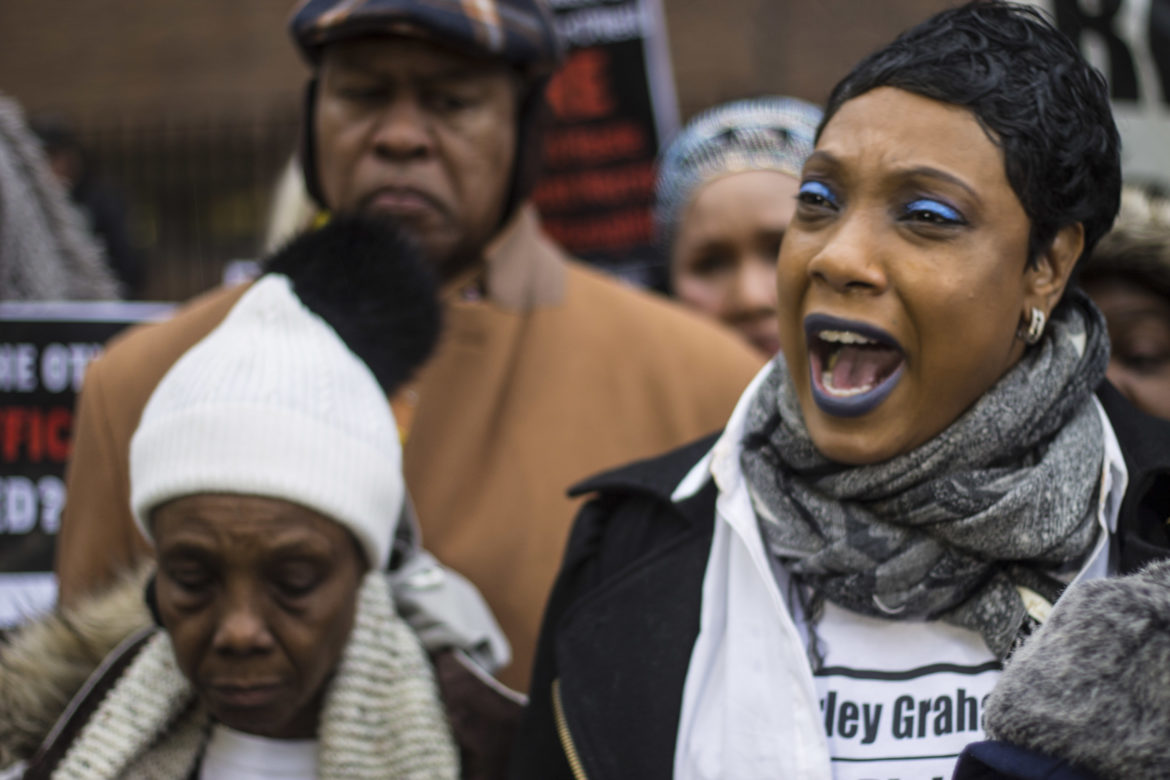NEW YORK — The New York Police Department officer who fatally shot 18-year-old Ramarley Graham could keep his job even if a department disciplinary trial ends with a guilty verdict. A ruling is expected within 90 days.
Prosecutors from the Department Advocate’s Office said in closing arguments Monday that police officer Richard Haste disregarded his training and violated department guidelines in the minutes before he killed the unarmed Bronx teenager on Feb. 2, 2012.
Defense attorneys argued that Haste acted reasonably when he burst into Graham’s home under the mistaken belief that the youth had a pistol.
 Department discipline is likely the last recourse against Haste after two local grand juries and a federal investigation declined to criminally charge him.
Department discipline is likely the last recourse against Haste after two local grand juries and a federal investigation declined to criminally charge him.
“What is this world coming to?” Graham’s mother Constance Malcolm asked outside police headquarters Monday. “We want justice. We want Richard Haste fired. We want him gone. We want the badge gone. We don’t need him in our community. We don’t need him on the street carrying a gun.”
The five-day trial was a rare example of an officer facing charges for poor “tactics” when the department had cleared him of wrongdoing in the resulting shooting. But Haste could still remain a police officer even if Deputy Commissioner Rosemarie Maldonado finds him guilty.
NYPD Commissioner James O’Neill would have to concur with Maldonado’s recommendation for punishment to terminate Haste. Defense attorney Stuart London told her in his closing arguments that two recent cases establish a precedent for police officers to keep their jobs after deadly decision-making.
One involved an officer who knocked a man down to his death after throwing a radio at him. The department cleared him although he later pled guilty to federal civil rights violations and served jail time. The other case resulted from an officer accidentally shooting a man while dragging him by the dreadlocks from underneath a car.
Haste had to make split-second decisions without the benefits of hindsight when he chose to enter the house to pursue Graham, London said. But prosecutors argued that the chase had already ended by the time Graham casually entered his building and locked the door behind him.
An “overzealous” desire to make an arrest led Haste to the backyard, said Nancy Slater, an attorney with the Department Advocate’s Office. Department guidelines allowed Haste to surround the building with fellow officers and request back-up. Instead Haste “raced” to the second floor after a resident allowed him into the building, Slater said.
[Related: After Plea Agreement, Anti-police Brutality Activist Gives Impassioned Statement to Court]
By this time Haste had lost sight of Graham for three minutes. A couch and houseplant obstructed the path to a third floor. A fellow officer who followed Haste into the house testified during the trial that he heard a woman’s voice coming from the third floor. Haste could have investigated but he and Police Officer John McLoughlin focused their attention on a door near the second-floor landing.
Haste testified Friday that he shouted for whoever was inside the apartment to open up. Then he and McLoughlin prepared to breach the door.
“We didn’t hear any verbal response but we heard some shuffling,” Haste said. “[I thought] he’s still here. I want to take him to custody to end this.”
Prosecutors called three expert witnesses to testify in the trial about police tactics. The closed door created a “barricade” situation that should have ended Haste’s pursuit, experts said. Individual police officers can request armored and heavily trained back-up at any time, prosecutors argued.
Haste’s defense countered that he felt unsafe on the landing and it was reasonable for him to burst into the apartment with his gun drawn after McLoughlin kicked the door open.
Haste could have concealed himself behind a wall as soon as he saw Graham at the other end of the hallway, prosecutors said. He also could have pinned Graham down after he went inside a room adjacent to the hallway, they said. But once again Haste opted to pursue a more reckless option rather than “isolate and contain” Graham per police guidelines, Slater said. He ran to the bathroom doorway and disregarded police training to minimize danger and maximize distance from armed suspects, she said.
“Haste took that critical piece of training and threw it out the window,” she said Monday.
The open door meant that Graham could have stuck an arm out of the bathroom at any time and fired at the officer, London said. Bullets can pierce interior apartment walls and there was nowhere to protect himself in the narrow hallway, he testified. This “do or die situation” required Haste to think fast to thwart an imminent threat to his life, he said.
The grandmother and brother who watched Graham die were potential victims in Haste’s mind as he moved down the hallway to confront Graham. Retreat was no option, according to London.
“What if three people had been murdered in that apartment? He would’ve been called a coward,” London said.
Slater concluded her case with a reminder that there never was a gun. Haste could have found that out without killing Ramarley Graham, she said. But after 175 arrests and more than eight years on the job, Slater said Haste has yet to realize how to go by the book that was central to his training.
“All these years later he still thinks he knows better than the Patrol Guide,” Slater said. “He doesn’t think he did anything wrong.”
Alejandra O'Connell contributed to this story.
More related articles:
‘Disturbing Schools’ Law and School Resource Officers Criminalize Teens
